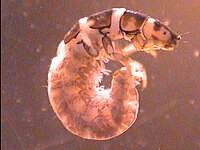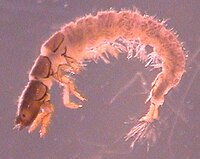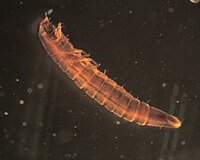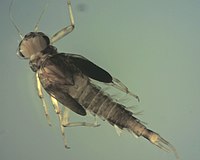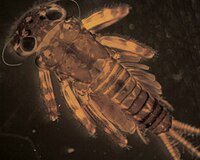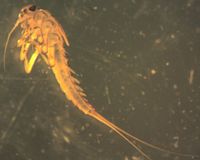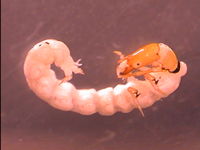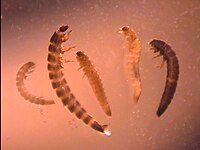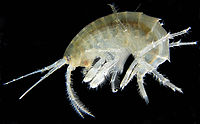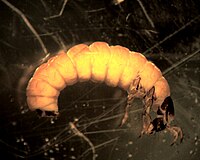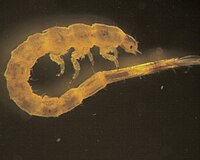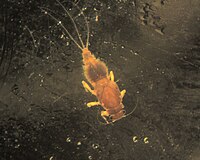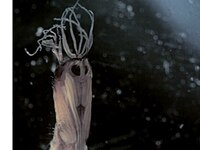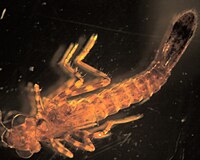Vermont EPSCoR's Streams Project; A Teacher Collaboration on WikiEducator
Openly shared content, practices, and developing resources from Vermont EPSCoR's Streams Project. Join this collaboration and make a difference!
 Fall Kill |
|---|
|
| Stream code: | HRD_FallKill_213 |
| Basin: | Hudson River |
| State or Province: | New York |
| Country: | USA |
| Latitude: | 41.749583 |
| Longitude: | -73.896486 |
| School: | Poughkeepsie High School |
The following are the most common invertebrates collected from this stream site.
Chironomidae
- Order
- Diptera
- Family
- Chironomidae
- Common name
- Nonbiting midge
- Tied fly
- Griffith's Gnat
Midge larvae tend to be the most common macroinvertebrate at our sites. As with other Diptera, there are no true jointed legs. Chironomidae do have a pair of prolegs at each end and preserved individuals tend to curl into a 'C'. Identification past family requires slide-mounted heads. We have seen philopotamid caddisflies misidentified with the chironomids and we suspect that that happens when samples are being sorted from trays. Under a microscope, six prominent legs can be seen on members of the caddisfly family Philopotamidae.
More information on Philopotamidae.
Ceratopsyche
- Order
- Trichoptera
- Family
- Hydropsychidae
- Genus
- Ceratopsyche
Ceratopsyche has a
forked foretrochantin. The foretrochantin is the projection at the uppermost portion of the foreleg. The leg may need to be pulled away from the body to expose this feature.
Ceratopsyche have a
large pair of sclerites underneath the prosternum. Note: the large single sclerite is the prosternal plate. Biologists have gone back and forth between lumping this genus into
Hydropsyche and splitting it back out. ITIS currently lists it as a genus (Feb 2013) but we are aware of a recent paper that lumped it under
Hydropsyche.
Cheumatopsyche
- Order
- Trichoptera
- Family
- Hydropsychidae
- Genus
- Cheumatopsyche
Cheumatopsyche has a
forked foretrochantin (as does
Ceratopsyche). The foretrochantin is the projection at the uppermost portion of the front leg closest to the head. The leg may need to be pulled away from the body to expose this feature.
Cheumatopsyche have a small or inconspicuous
pair of sclerites under the prosternal plate that are difficult to see. Contrast that with the
larger pair of sclerites found on Ceratopsyche. To access sclerites, it's best to gently pull the pronotum and mesonotum in opposite directions. Note: the large single sclerite is the prosternal plate.
Cheumatopsyche have only 2 types of
hair on the abdomen: long thin plain hairs and thicker club hairs, which are narrow close to the body and widen out at the distal end. Paired sclerites on the ninth abdominal segment are notched.
Stenelmis
- Order
- Coleoptera
- Family
- Elmidae
- Genus
- Stenelmis
The larvae of
Stenelmis, as in
Ordobrevia, have a sternum on the ventral side of the pronotum. The main difference between the two genera is in the antennae the second segment is less than twice as long as the first in
Stenelmis.
The adult Stenelmis has a clear separation between the thorax and abdomen as well as a more distinctly separate head as compared to other genera.
Click here to see pictures of the sternum and
antennae-
Acerpenna
- Order
- Ephemeroptera
- Family
- Baetidae
- Genus
- Acerpenna
- Common name
- Tiny blue-winged olive
This genus is can be identified by the costal process, or projection, distal to the hind wing pad. Gill 7 is slender and may be pointed at the end. The antennal scape and pedicel have a few scattered setae (hairs).
Image of the antennal scape. A ventral view can be seen here.
Maccaffertium
- Order
- Ephemeroptera
- Family
- Heptageniidae
- Genus
- Maccaffertium
- Common name
- The March Brown
- Tied fly
- March Brown
This genus of
Heptageniidae is distinguished by its gills on the seventh abdominal segment, which are reduced to slender filaments. Gills on segments 1-6 are truncated.
Images of the slender filaments, and the truncated gills.
Baetis
- Order
- Ephemeroptera
- Family
- Baetidae
- Genus
- Baetis
- Common name
- The Little Olive
- Tied fly
- Sawyer Pheasant Tail Nymph
This mayfly has three "tails" and a unique head shape. Its gills are oval shaped and insert dorsally. More mature nymphs have long, dark wing pads.
Image of the long, dark wing pads.
Chimarra
- Order
- Trichoptera
- Family
- Philopotamidae
- Genus
- Chimarra
Chimarra are distinguished from the other Philopotamidae by a prominent asymmetrical notch in the frontoclypeus as well as a prominent process on the femur which bears a single hair (seta).
Images of the asymmetrical notch and prominent process.
Elmidae
- Order
- Coleoptera
- Family
- Elmidae
- Common name
- riffle beetle
We very commonly find adult and larval riffle beetles. The adults are clearly beetles, but the larvae can be confused with other orders. The forward pointing tooth on the front end of the larvae as described in the key can be a challenge to see, particularly in small individuals. Larvae are characterized by having a single tarsal claw at the end of their legs, which have 4 segments. Adults, on the other hand, have two tarsal claws at the end of each leg. Commonly encountered genera include
Dubiraphia,
Macroychu,
Optioservus,
Phanocerus,
Promoresia, and
Stenelmis.
Images of the adult and larval riffle beetles.
More information on Dubiraphia, Macronychus, Optioservus, Phanocerus, Promoresia, and Stenelmis.
Nigronia
- Order
- Megaloptera
- Family
- Corydalidae
- Genus
- Nigronia
Members of the genus
Nigronia share some superficial commonalities with Trichoptera, but on careful inspection one can see the two pair of anal claws that help place it in the order Megaloptera. The size of mature larvae is impressive; specimens from other genera exceed 8 cm in length. The abdominal segments have ribbon-like gills on the lateral portions. The mouth has mandibles that are serrated and used for biting prey. They can be confused with the more slender whirling beetle larvae; whirligig larvae also have simpler jaws.
Images of the two pairs of anal claws, whirligig beetle larvae and their simpler jaws.
Gammaridae
- Order
- Amphipoda
- Family
- Gammaridae
The body of this scud is flattened side-to-side. It has seven pairs of walking legs and two pairs of antennae. On third third antennal segment, there is a segmented flagellum.
Images of the body flattened side-to-side, and the segmented flagellum.
Glossosomatidae
- Order
- Trichoptera
- Family
- Glossosomatidae
- Common name
- saddlecase caddisfly
Larvae in this family build domed cases made of small rocks, and are often wider at segment 5. The pronotum is covered in dark, sclerotized plates, but there are either
no sclerites on the mesonotum, or the mesonotum is unsclerotized with the exception of a few patches. The anal proleg is broadly joined to segment 9; the anal claw has one or more accessory hooks. The
pronotal excision is small (approximately 1/3 anterolaterally) to accommodate the coxae.
Commonly encountered genera include Glossosoma and Agapetus.
Dubiraphia
- Order
- Coleoptera
- Family
- Elmidae
- Genus
- Dubiraphia
The larvae of this genus are distinguished by the last abdominal segment, which is very elongated. Adults of this genus usually have prominent longitudinal markings on their elytra and, like adult
Optioservus, have a fringe of tomentum on their anterior tibia.
Image of the fringe of tomentum.
Caenis
- Order
- Ephemeroptera
- Family
- Caenidae
- Genus
- Caenis
- Tied fly
- Tiny Graywinged
These mayflies are characterized by square-shaped operculate (plate-like) gills on the second abdominal segment.
Diptera
- Order
- Diptera
- Tied fly
- Griffith's Gnat
Pupae from the order Diptera are typically found in small numbers at every site. These can be identified further, but we do not.
Coenagrionidae
- Order
- Odonata
- Family
- Coenagrionidae
- Common name
- narrowwinged damselflies
- Tied fly
- Polly's Green Damsel
These damselfly larvae (sub-order Zygoptera) can be distinguished from dragonfly larvae (sub-order Anisoptera) by their more slender bodies and the presence of three leaf-like gills at the end of the abdomen and The family Coenagrionidae is characterized by its distinctly shaped labium which may or may not be extended.
Images of the gills at the end of abdomen, and another here. An image of the labium, and an extended labium.


